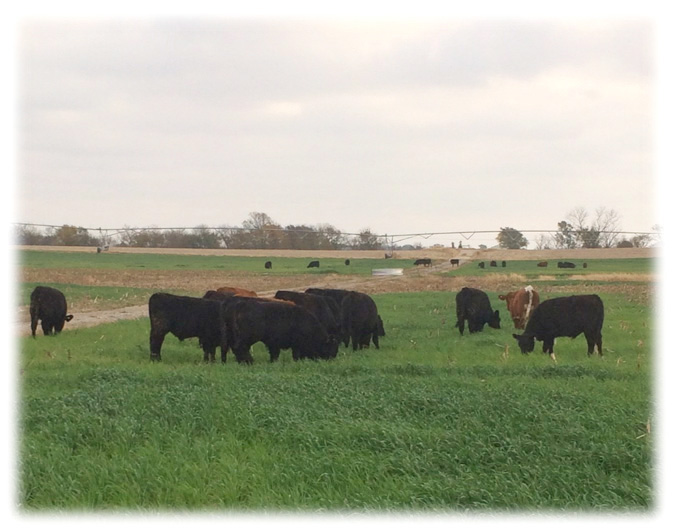
By Kristen Ulmer and Mary Drewnoski, Extension Beef Systems
Late-summer-planted forages like small grain and brassica mixes can afford quality forage for grazing of backgrounded calves in the fall and early winter season.
WHAT TYPE OF FORAGE TO PLANT?
Annual forages such as brassicas (purple top turnips, rapeseed and forage collards), oats and triticale are a few that provide good fall grazing, meaning September to January time frame with planting window of Aug. 1 to mid-September. If interested in fall planting for April to June grazing, select a winter hardy species like cereal rye, winter triticale or winter wheat.
Brassicas are best described as “alfalfa plus corn grain in water,” meaning they are high protein, ranging from 15–20% crude protein (CP), 75–85% total digestible nutrients (TDN, a measure of energy) and are around 15% dry matter (DM) at grazing in November. Calves grazing solely brassicas is concerning as the low fiber and high sulfur content of brassicas can lead to sulfur toxicity. Putting out a bale of hay to add fiber to the diet, or putting a higher level of oats into the mix at planting, would alleviate the challenge as well. A forage mix seeded at 50 lbs of oats and 3 lbs
of rapeseed per acre was evaluated by UNL and found to have 15.5% CP and had a higher digestibility than the grazed monoculture oats.
WHEN WAS THE FORAGE PLANTED?
When brassica and oat mixes are planted after corn silage harvest (early September) and water and nitrogen are adequate, up to two tons of forage dry matter grows, depending on the planting date and forage species selected. The earlier in the window, the more forage you will get. If forage is planted before the window, the grass will start to go into reproductive stages, producing very little biomass and mainly stem.
Research at UNL indicates that winter sensitive species like oats and brassicas should be planted before Sept. 1 in order to graze by early November. Planting a week to two weeks later can decrease forage production of annual forage mixes to as little as 500 lbs of forage dry matter. At that point, the forage may be best used as ground cover. Two weeks of growing-degree days provides considerably more forage, so planting date highly impacts annual forage yields.
What if you hold off until late December or January to graze? As long as there is not thick ice over the brassica mix, cattle will dig to eat the forage. The mix may look brown and kind of melted looking, but the quality of brassicas and oats around December and January is still very good (15–20 % CP and 70–80% TDN). Color is not a good indicator of quality.
HOW DO CALVES PERFORM?
Fall and early winter grazing on annual forages is a great opportunity for backgrounded or stocker calves. Annual forages offer a high quality diet that meets nutrient requirements of growing calves. Generally, stocking rate of calves in most UNL studies has been about one calf per acre and grazing period ranges from 40–70 days. Between balancing how much cover you should leave to prevent soil erosion, to deciding when to pull calves if weather becomes tough (like ice or too deep of snow that would limit the amount of intake), the number of grazing days can vary considerably.
The average daily gain (ADG) of calves on oats or oat-brassica mixes in UNL studies ranges from 1.0–3.0 lbs/day. Lower gains noticed in UNL research correlated to not pulling calves early enough (“overgrazing” type of scenario) or wet winter weather (more energy was used by the calf to stay warm). Targeting 2–3 inches of oats remaining seems to be a good compromise and results in 70% ground cover as compared to 30% cover when the oats were planted directly following corn silage harvest at the end of August.
Make sure to consider the herbicides applied to crop fields earlier in the season, since some herbicides have grazing restrictions or may restrict the growth of some plants. A UNL study tried to seed turnips and oats after corn harvest for grazing, but found cover crops were unable to be grown for cattle grazing due to specific chemicals applied for corn harvest.
Overall, annual forages, such as brassica-oat mixes, yield good forage when planted in late summer, and provide a high-protein and high-energy diet for a growing calf grazing in the fall. Alternative grazing options can add value to an annual forage already being planted as soil cover for the next crop.